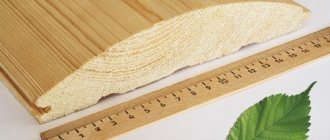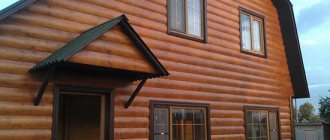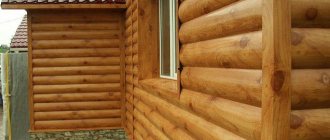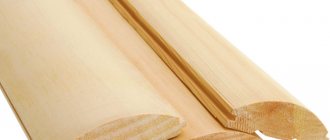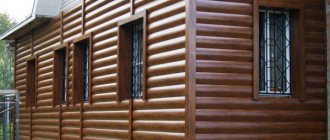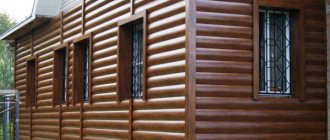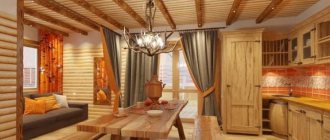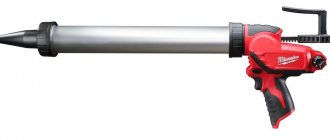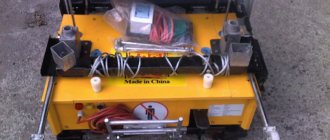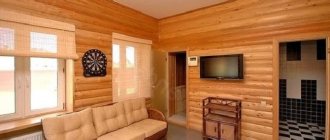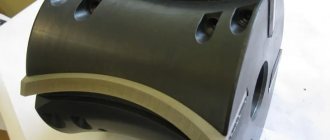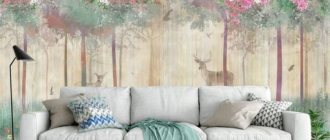Features of the block house profile
Many consider the block house to be a special type of lining with a rounded front part. In fact, the scope of application and manufacturing technology of this material are similar to lining, but the block house is a facing profiled board that imitates a rounded log.
This material came to Russia from the West. Translated from English, “blockhouse” means block house. A block house is what we call a frame house. Covering the walls with block house boards allows you to create an imitation of a wooden house built from rounded logs.
Each board has a special profile. On its back side, longitudinal grooves are made by milling. Their purpose is to remove moisture and ventilate the skin, relieving stresses arising due to sudden changes in temperature and humidity. Many modern profiled wood materials have such structural elements.
The back side of the block house.
An important detail of a house block is a high-quality lock, which is a connecting tongue and groove.
This connection of panels provides:
- no gaps between cladding elements;
- the ability to hide fastening parts - clamps, nails or screws are hidden by the next board;
- reduction of finishing time.
Installation features
Despite belonging to the lining, the methods of fastening to the sheathing when cladding a house externally with a block house are different than when carrying out internal work.
Inside, narrow modifications of panels of small thickness (up to 20-22 mm) are used, and operating conditions are characterized by stable humidity and temperature. Therefore, the house block can be fixed to the sheathing using hidden mounting fasteners - clamps. Exterior finishing is carried out with a thick and wide cladding board, in which, when humidity changes, such internal stress forces arise that it can simply be torn out of its grip.
Wood species used for the production of block houses
Almost any wood is suitable for manufacturing. The most popular types of wood are spruce or pine. It is possible to use hardwoods as raw materials: oak, linden, aspen, alder.
Block house made of pine.
Angara pine has impeccable performance characteristics. This material belongs to the luxury class. It has no falling knots, is well processed, and has an attractive shade. As a rule, such boards are used for finishing solid and expensive houses.
A block house made of larch is well appreciated. The boards have a characteristic whitish tint and are not susceptible to destruction by pathogenic flora. In addition to cladding houses, larch material is often used for cladding baths. Its wood does not release resin at high temperatures, which eliminates skin burns and damage to the appearance of the wall.
Block house made of larch.
Due to the higher price, profiled oak boards are used less frequently. Although oak wood is aesthetically pleasing and durable, its grain pattern becomes dull over time. To maintain the attractive appearance of such cladding, it is necessary to properly care for it.
Due to the low strength characteristics and reduced durability of the cladding, dead wood or firewood is not used for the manufacture of panels. The forest selected for processing must be healthy and alive.
Video description
For a clear overview of finishing a block house, watch the video:
The second reason that does not allow the use of clamps for external cladding is the way the block house is located on the facade. The groove into which the bracket “clings” should face down (so that moisture does not get into it). And with this orientation, installation of panels on clamps can only be done from top to bottom.
Therefore, the outer cladding is carried out in one of two ways:
- Open. The panel is screwed to each beam at two points - from the groove side and closer to the tenon. Before fastening, holes are drilled into which screws are screwed in with force so that their heads do not protrude above the surface of the panel. Then these places are puttied, disguising them as a small knot. This installation method is the most reliable and is recommended for thick and wide house blocks.
- Hidden. The bottom panel near the groove is fastened in an open manner, plus holes are drilled at the base of the tenon at an angle of 45° into which self-tapping screws are screwed. Each subsequent row of block house (except for the last) is fixed only through a spike. The top row is fastened in an open way.
Tenon fastening makes installation hidden Source hi.decoratex.biz
Note : Due to fluctuations in humidity, the tree changes its size across the fibers - it swells or shrinks. Therefore, it is necessary to ensure that during installation there remains a small gap between the groove stop of the upper row and the tenon of the lower one. If workers miss this nuance, then over time the wall will deform.
Block house production technology
The blank for making the material is a board obtained after sawing logs. The production process is divided into 4 stages.
Log sawing
Logs of suitable size are pre-selected. First, they are sawn into boards using the “square in a circle” technology. It received this name due to the fact that the result of sawing is a square beam and side external elements. It is the latter that go into making a block house. Next, the blanks are transferred to other machines and modified in width.
Scheme of sawing a log.
Drying workpieces
The resulting boards are placed in chamber drying units. This allows the wood moisture content to be reduced to the norm of 12%. When this parameter is reached, the material becomes resistant to the negative effects of the environment - precipitation in the form of rain and snow. In addition, drying prevents the formation of blue stains in the wood.
Loading boards into the dryer.
Trimming and planing boards
The most important stage, during which the modified workpieces are processed using high-tech modern equipment. Fastening elements - tenons and grooves - are cut with high precision, and air channels are made. Since at this stage the board already has a perfectly polished surface, no additional processing is required.
Machine for making block house profiles.
Sorting and packaging
The resulting block house is sorted by quality class - appearance. After this, the material is securely packaged in film.
Packed block house.
Block house varieties and what documents they are regulated by
In our country there are no GOST standards regulating the production of block houses. For this reason, manufacturers focus on those standards that are suitable for specific production conditions. Due to the lack of standards, you can find a wide variety of block house and its varieties on the market.
Most often, domestic manufacturers use the Soviet GOST 8242-88 “Profile parts made of wood and wood materials for construction,” which is used for the production of lining.
In particular, they are guided by its rules regarding:
- permissible geometric deviations when cutting elements;
- processing parameters and surface roughness;
- acceptable product defects;
- humidity criteria (12% - inside, 15% - outside);
- rules for transportation and packaging of products;
- ways to check quality characteristics.
Foreign regulations are more stringent. Many people use the German version of material standardization in accordance with the standards “Solid softwood paneling and cladding - Machined profiles with tongue and groove; German version EN 14519:2005".
This pan-European standard has the name: “Panels and cladding made of solid coniferous wood - with profiled groove and tongue.” This regulation has standards similar to the domestic GOST and provides for the division of block houses into quality classes “A” and “B”.
As for Russia, there is no precise classification of block houses by grade. The names of the categories can be whatever you want (as is more convenient, “Classic”, “grade A or B” or intermediate types - “AB”, there may even be a 3rd grade - C.
Let us give an approximate classification by categories and varieties, which is used most often.
“Extra” grade – the highest
It does not allow the presence of cracks, knots and other small flaws in the material. There are no traces of mechanical processing - the profiled board has an ideal surface on the front side.
Grade "A"
Any mechanical damage to the material is not allowed. On 1 meter of the board there should not be: resin pockets longer than 30 mm, 2 or more knots with a diameter greater than 30 mm.
Grade "B"
Per meter of length, a board may have no more than one mechanical damage on the inside resulting from processing. The presence of knots per 1 meter is no more than 4, diameter up to 30 mm. The surface with knots should be light, the texture of the wood should be vibrant.
Grade "C"
It is possible to have any number of dark and light knots, the diameter of which does not exceed 30 mm.
Products of higher grades have a slightly higher price. They are used to decorate the interior walls of a house or apartment.
Wood selection criteria
Even Block House vinyl siding has certain characteristics that indicate the quality of the façade panels. Wood is a “thinner” material, and the durability of the outer cladding largely depends on the right choice. Therefore, it is not enough to assess the suitability of the variety - the density, resistance to moisture and strength of the wood are important.
To decorate the house with a block house, only coniferous species are used. Hardwoods (linden, oak, ash) are used for interior wall cladding.
Larch is considered an elite material and its qualities a priori correspond to outdoor conditions: high humidity and exposure to precipitation. The density and strength of Russian larch, like that of a northern tree species (after all, it grows in Siberia), will also be at a high level.
Larch has dense and durable wood, so it is not for nothing that it belongs to the elite of coniferous species Source pilomateriali-fanera.ru
With pine it is not so clear. Northern pine is most suitable for facade finishing - its strength and density are much higher than that of wood from warm regions. And the origin of a pine block house is determined by the distance between the annual rings - the closer they are to each other, the better. The quality criterion is at least three rings per 1 cm of end cut.
See also: Catalog of companies that specialize in facade materials.
Block house dimensions
The thickness of the material is measured from the highest point of the front surface perpendicular to the back side. As a rule, a board is made with an optimal cross-sectional proportion - the thickness corresponds to the width of the material. This is how its strength characteristics are maintained, since boards of greater width and insufficient thickness are susceptible to cracking and warping.
When ordering material, it is important to consider that the working and overall width of the block house are divided. After installation, part of the board is hidden - the tenon entering the groove of the adjacent panel is covered by it.
Working width is the part that is visually visible after assembling the shield.
Working size.
Dimensions of a block house for exterior finishing
The requirement for external cladding is resistance to the external environment. Coniferous wood material is used for exterior finishing. The facade is sheathed with boards with a more convex profile.
Block house for exterior finishing.
Most often, panels from 3 to 6 meters long are used for exterior wall cladding, having the following dimensions:
- 140 x 30 mm;
- 142 x 36 mm;
- 190 x 36 mm.
According to standard sizes, boards for external finishing are conventionally divided into:
- universal – 3 or 6 meters long with dimensions 42 x 36 mm;
- wide universal - 2, 3 or 6 meters long with dimensions 142 x 28 mm;
- wide facades - 4 or 6 meters long with dimensions 193 x 36 mm.
The house is finished with a block house.
Aesthetic properties
One of the undoubted advantages of a block house is its aesthetics. Using this lumber to cover the facades of a house made of concrete, foam block, brick or timber, you can give the building the appearance of a real log house. At the same time, exterior decoration, in addition to changing the appearance of the house, will allow:
READ MORE: How to decorate a kitchen in a neoclassical style?
- protect walls from external negative factors (moisture, cold, ultraviolet radiation, wind);
- provide additional thermal insulation provided that insulation is used during the installation of the block house.
Please note: the scope of application of this finishing material is quite wide - it is successfully used not only for finishing the facades of houses, but also when decorating gazebos, verandas, baths, as well as in the interior. For interior decoration, it is worth choosing narrow panels with a slightly convex front side, thereby minimizing the concealment of space in the rooms.
Walls decorated with a wooden block house look not only natural, but also especially expressive, and therefore look harmonious with almost any interior design.
